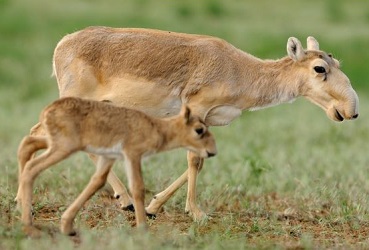Kazakhstan’s Endangered Antelopes Dying By the Thousand
BONN, Germany, July 9, 2015 (ENS) – More than 120,000 saiga antelope have been confirmed dead in central Kazakhstan, more than a third of the global population of this critically endangered mammal. Wildlife experts believe that a combination of environmental and biological factors is contributing to the die-off.

Mother saiga and calf in the steppe in Cherniye Zemly (Black Earth) Nature Reserve, Kalmykia, Russia. (Photo by Igor Shpilenok)
Historically, this was a common species in Eurasian steppes and semi-deserts. Between 1991 and 1994, the global population of saiga antelopes, Saiga tatarica, was relatively stable at just under one million animals, the majority of which were in Kazakhstan. However, the population in Kazakhstan had fallen to around 570,000 animals by 1998, according to the IUCN Red List of Threatened Species.
Saigas have in the past 10 years only begun to recover from a global population size of less than 50,000 animals following a 95 percent crash in numbers.
At the request of Kazakhstan, the Secretariat of the Convention on the Conservation of Migratory Species of Wild Animals, CMS, despatched an emergency mission in June with experts from the Royal Veterinary College in the United Kingdom and the Food and Agriculture Organization to assist with post-mortem examination and analysis.
Four large birth aggregations of saigas have died since mid-May. The carcasses of mothers and calves are most often found; not a single animal survived in the affected herds.
Erlan Nysynbaev, Kazakhstan’s vice minister of agriculture, said in Astana, “This loss is a huge blow for saiga conservation in Kazakhstan and in the world, given that 90 percent of the global saiga population is found in our country. It is very painful to witness this mass mortality.”
“We established a working group that includes all relevant experts, including international ones, and are determined to identify the causes and undertake all possible efforts to avoid such events in the future,” said Nysynbaev.
Members of the CMS expert mission report that two “secondary opportunistic pathogens,” specifically Pasteurella and Clostridia, are contributing to the rapid and wide-spread die-off.
Yet, these bacteria are only lethal to an animal if its immune system is already weakened, so the experts are still searching for the fundamental drivers of the die-off.
Samples from the affected saigas as well as the vegetation and soil of the area have been collected and are currently being analyzed.
“Experts are working around the clock to investigate the impacts in terms of wildlife health of the relatively high rainfall observed this spring, the composition of the vegetation and other potential trigger factors including a suite of viruses. … Fresh laboratory results are becoming available every day,” says Aline Kühl-Stenzel, terrestrial species officer at the UNEP/CMS Secretariat, who has been supporting the expert mission remotely from the Convention’s headquarters in Bonn.
“Symptoms of the saiga affected include foam around the mouth and diarrhoea. Primarily adult females and newly born calves have been affected, since mid-May is the period when females aggregate in vast herds to all give birth within a peak period of only one week. It appears that one or several large birth aggregations have been eradicated”, said Kühl-Stenzel.
Some Kazakh environmentalists blame rocket fuel raining down onto saiga habitat after several Russian rockets exploded after launch from a Kazakh location.
But Kühl-Stenzel says, “None of the data analyzed to date indicates that rocket fuel is related to the mass die-off.”
Conservationists have hope for recovery because saiga regenerate quickly. In years with a favorable climate the population can increase by up to 60 percent in a single year. Very few animals in a population are more than 3.5 years old, indicating that the population is almost completely renewed after four years, says the IUCN Red List.
CMS Executive Secretary Bradnee Chambers said, “Authorities in Kazakhstan are responding quickly to this disaster and are working hard to solve the mystery behind this mass saiga die-off. I am pleased that the international expert mission we were able to send, at very short notice, is now contributing to these efforts.”
The CMS Secretariat in close collaboration with the CITES Secretariat is currently preparing a meeting of all five Signatories of the Saiga Memorandum of Understanding – Kazakhstan, Mongolia, the Russian Federation, Turkmenistan and Uzbekistan – as well as consumer countries of saiga products, to review progress and to agree to urgently needed measures.
Copyright Environment News Service (ENS) 2015. All rights reserved.
http://ens-newswire.com/2015/07/09/kazakhstans-endangered-antelopes-dying-by-the-thousand/